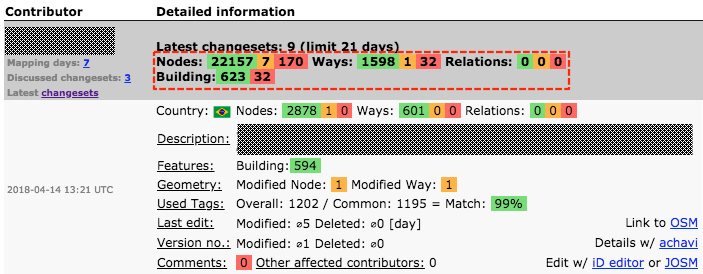Adding Indicators to OSM Map Edits Assessment
by Pascal Neis - Published: April 15th, 2018
Almost two years ago I published a web service that finds suspicious OpenStreetMap (OSM) map changes. You can use the service here and find some more information in previous blog posts. Especially Changeset discussions revealed that they are more or less de facto standard for communication between contributors during map change reviews.
However, when I am inspecting map changes, I sometimes see new contributors using uncommon OSM tags. Therefore I think it could be useful to add an additional assessment parameter to the aforementioned suspicious OSM map changes page. The newly introduced indicator states the matching ratio between the contributed and the most popular OSM tags. This means, if the changeset contributor used many uncommon tags at her/his map changes objects, the matching rate will be low. If the contributor applied many common (“popular”) tags, it results in a high matching rate towards 100%. For the calculation I used Jochen Topf’s taginfo API to get commonly used OSM tags. An API description can be found here. Furthermore I added the average age (in days) of modified and deleted objects. This indicator can be used to see if the contributor edited objects, which have been mapped today (0 days) or exist already for a longer period of time, e.g. 1566 days. The values for the average version numbers are computed in a similar fashion.

Last but not least, the number of the affected contributors of the changeset is calculated. If a contributor only changes objects on which she or he is the latest modifier, this number will be ‘0’. Otherwise the value represents the number of unique mappers whose contributions have been changed. I hope that overall the newly added indicators can be useful for identifying changesets which need a closer look. The suspicious OSM map changes website has also received some style updates. They should help to highlight the most important parameters. I also added the aggregation of the latest changesets for a specific contributor. Guess this could be really useful to see a “big picture” of the individual mapping activities.

The aforementioned service is online here –> “Find Suspicious OpenStreetMap Changesets”
Thanks to maɪˈæmɪ Dennis.
Thanks for the great page and update. Is the interface Opensource? Would you mind putting it on github? This way people could contribute, eg with the design of the Page.
Hi Tobias, thanks for your comment. The page is written in PHP with a connection to the Postgres database. It’s not an Interface or something similar.